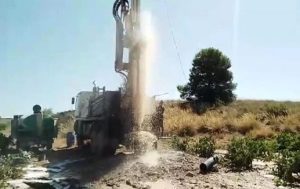Exploring the Depths: The Rotopercussion Survey Method

-
In the search for water, mineral and geothermal resources, as well as for the construction of safe and stable foundations, the rotopercussion drilling method has proven to be an invaluable tool.
-
This method combines the rotation of a drill bit with percussion to penetrate layers of rock and soil, offering an effective way to explore and evaluate subsurface characteristics.
-
In this article, we will explore in detail the rotopercussion probing method, its working, applications and advantages.
Operation of the Rotopercussion Method
The rotary percussion method involves the use of a drilling tool that combines two main actions: rotation and percussion. First, a rotary drill bit, equipped with tungsten carbide teeth or buttons, is used to cut and grind the subsurface material. As the bit rotates, a percussive force is applied to it, usually through a hollow drill rod, which repeatedly strikes the bit to help break up harder rock layers. This combination of rotation and percussion allows you to effectively penetrate different types of geological formations, from soft rocks to hard, consolidated rocks.
Applications of the Rotopercussion Method
The rotary percussion method is used in a variety of applications in different industries:
- Geothermal Exploration: In the search for geothermal resources, such as hot springs and geothermal steam, the rotopercussion method is crucial for drilling exploration and production wells in deep rock formations.
- Groundwater Harvesting: For the construction of groundwater wells, this method is used to drill through various layers of soil and rock and access underground aquifers.
- Mining and Mineral Extraction: In the mining industry, it is used to explore mineral deposits, as well as to extract soil and rock samples for geological and geochemical analysis.
- Civil Engineering and Construction: In civil engineering and construction projects, such as the construction of foundations for buildings and structures, the rotopercussion method is used to conduct soil and rock studies and determine the suitability of the subsoil to support structural loads.
Advantages of the Rotopercussion Method
The rotary percussion method offers several significant advantages compared to other drilling methods:
- Versatility: The ability to combine rotation and percussion allows you to penetrate a wide variety of geological formations, from soft soils to hard, consolidated rocks.
- Speed and Efficiency: The cutting and grinding action of the bit, combined with percussive force, allows drilling through layers of soil and rock quickly and efficiently, resulting in shorter drilling times and reduced costs.
- Sample Control: The rotopercussion method provides high-quality, representative soil and rock samples, allowing for accurate geological, geochemical, and engineering analyses.
- Adaptability: The ability to adjust rotation speed and percussive force allows the method to be tailored to specific subsurface conditions, thus optimizing drilling performance.
In conclusion, the rotopercussion drilling method is a versatile and effective tool for exploring and evaluating subsurface characteristics in a variety of industrial and geotechnical applications. With its ability to penetrate various geological formations and provide high-quality samples, the rotopercussion method continues to play a crucial role in the research and extraction of natural resources, as well as the construction of safe and sustainable infrastructure.
For illustrative purposes, an image of machinery carrying out a groundwater extraction survey using rotary percussion as a method is shown below:

José Luis De la Rosa